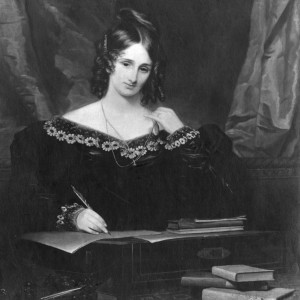WSJ Historically Speaking: Dreams That Created Literary Masterpieces

Mary Wollstonecraft Shelley, the British writer best known for ‘Frankenstein,’ and second wife of poet Percy Bysshe Shelley. PHOTO: HULTON ARCHIVE/GETTY IMAGES
Dreams have been the stuff of divine inspiration ever since Jacob, in the Book of Genesis, dreamed of a ladder that connected heaven and earth.
In the “Divine Comedy” (completed in 1320), Dante Alighieri wrote of the three dreams that beset him while traveling through Purgatory. In 1678, John Bunyan claimed that “The Pilgrim’s Progress” had come to him while sleeping: “I layed me down in the place to sleep: and as I slept, I dreamed a dream.”
The Romantics, because of their obsession with the sublime, were particularly sensitive to dreaming. The poet William Blake inhabited a twilight of visions and dreams. “O, what land,” he wrote, “is the land of Dreams?” It was a place so real and vivid to him that Blake claimed his method for relief etching—which he used to combine text and color images in “illuminated printing”—was the gift of his late younger brother, Robert, who explained it in a dream.
Critics still debate what fueled Blake’s visions and whether they were the result of mental illness. There is no doubt, however, that copious amounts of laudanum helped in the creation of Samuel Taylor Coleridge’s 1797 poem “Kubla Khan.” Coleridge admitted that “In Xanadu did Kubla Khan / a stately pleasure dome decree” came to him “in a sort of Reverie brought on by two grains of Opium taken to check a dysentery.” He claimed that he awoke with 200 to 300 lines already composed in his head. But the poet had only managed to write 54 of them when a visitor at the door interrupted his train of thought. By the time Coleridge returned to his desk, the rest had vanished from his mind.
“Kubla Khan” would never have been known were it not for the insistence of Lord Byron, who persuaded Coleridge to allow it to be published. Byron was also responsible, in a roundabout way, for the vision that inspired Mary Shelley to write “Frankenstein.” In the summer of 1816, the Shelleys were part of a small group of guests staying with Byron on Lake Geneva in Switzerland. The weather was so atrocious that he suggested a competition to write the scariest ghost story.
Mary was stymied for the first couple of days, but on the night of June 16, between 2 and 3 a.m., she “saw—with shut eyes but acute mental vision—I saw the pale student of unhallowed arts kneeling beside the thing he had put together. I saw the hideous phantasm of a man stretched out, and then, on the workings of some powerful engine, show signs of life.” Inspired by the vivid nature of her dream, Mary labored for the next two years, writing and revising the manuscript.
By contrast, Robert Louis Stevenson spent only about six weeks on his dream-inspired work, “Strange Case of Dr. Jekyll and Mr. Hyde.” Suffering from what may have been bronchiectasis, deeply in debt and dependent on powerful stimulants to manage the hemorrhaging in his lungs, Stevenson’s dream in 1885 was a full-blown nightmare from which he awoke screaming. The first draft was allegedly so disturbing that it ended up in the flames. The second draft was finished in a matter of weeks. That, too, was considered beyond the pale of decency and had to be toned down for public consumption.
Before aspiring writers pray for a nightmare or reach for mind-altering drugs, they should remember E.B. White’s simple explanation for “Stuart Little”: “Many years ago, I went to bed one night in a railway sleeping car, and during the night I dreamed about a tiny boy who acted rather like a mouse. That’s how the story of Stuart Little got started.”
Let us all dream on.
